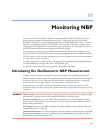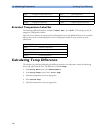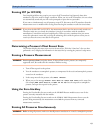
Choosing the NBP Alarm Source 10 Monitoring NBP
147
Choosing the NBP Alarm Source
You can monitor for alarm conditions in systolic, diastolic and mean pressure, either singly or in
parallel. Only one alarm is given, with the priority of mean, systolic, diastolic. In the
Setup NBP
menu, select
Alarms from and choose from:
Assisting Venous Puncture
You can use the NBP cuff to cause sub-diastolic pressure. The cuff deflates automatically after a set
time (adult/pediatric 170 seconds, neonatal 85 seconds) if you do not deflate it.
1 In the NBP Setup menu select VeniPuncture.
2 Puncture vein and draw blood sample.
3 Reselect VeniPuncture to deflate the cuff.
During measurement, the NBP display shows the inflation pressure of the cuff and the remaining time
in venous puncture mode.
Calibrating NBP
NBP is not user-calibrated. Cuff-pressure transducers must be verified and calibrated, if necessary, at
least once every two years by a qualified service professional. See the Service Guide for details.
Menu option Pressure value monitored
Sys. systolic
Dia. diastolic
Mean mean
Sys&Dia systolic and diastolic in parallel
Dia&Mean diastolic and mean in parallel
Sys&Mean systolic and mean in parallel
S&D&M all three pressures in parallel
(60)
Cuff pressure
Venous puncture measurement mode
VP
NBP
01:45
Time left in venous
puncture mode


















